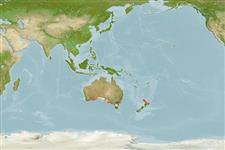Environment: milieu / climate zone / depth range / distribution range
Ecología
marino; salobre; rango de profundidad 0 - ? m. Tropical; 32°S - 40°S (Ref. 75154)
Western Pacific: endemic to Australia.
Tamaño / Peso / Age
Maturity: Lm ? range ? - ? cm
Max length : 31.5 cm SL macho / no sexado; (Ref. 9843)
Espinas dorsales (total): 0; Radios blandos dorsales (total): 13-15; Espinas anales 0; Radios blandos anales: 11 - 14; Vértebra: 52 - 55. This species is distinguished by the following characters: one dark spot on sides of body (below the dorsal fin); anal-fin rays 11-14 (usually 12-13); dorsal fin with well-developed anterior lobe, pigmented on anterior part; body width 1.3-1.8 times its depth; absence of scales on upper jaw; no preorbital ridge (Ref. 9843).
A coastal species mostly found in more turbid inshore waters replacing Hemiramphus far, which is more common in more oceanic waters (Ref. 9843). Inhabits estuaries (Ref. 75154). A high quality food fish well-known in markets of Brisbane, Queensland (Ref. 9843).
Life cycle and mating behavior
Madurez | Reproducción | Puesta | Huevos | Fecundidad | Larva
Collette, B.B., 1999. Hemiramphidae. Halfbeaks. p. 2180-2196. In K.E. Carpenter and V. Niem (eds.) FAO species identification guide for fishery purposes. The living marine resources of the Western Central Pacific. Vol. 4. Bony fishes part 2 (Mugilidae to Carangidae). FAO, Rome. (Ref. 9843)
IUCN Red List Status (Ref. 130435)
Threat to humans
Harmless
Human uses
Pesquerías: comercial
Más información
Nombres comunesSinónimosMetabolismoDespredadoresEcotoxicologíaReproducciónMadurezPuestaAgregación para la puestaFecundidadHuevosEgg development
ReferenciasAcuiculturaPerfil de acuiculturaRazasGenéticaElectrophoresesheritabilidadEnfermedadesProcesamientoNutrientsMass conversion
ColaboradoresImágenesStamps, Coins Misc.SonidosCiguateraVelocidadTipo de nataciónSuperficie branquialOtolitosCerebrosVisión
Herramientas
Special reports
Download XML
Fuentes de Internet
Estimates based on models
Preferred temperature (Ref.
123201): 15.7 - 20.6, mean 17.9 °C (based on 137 cells).
Phylogenetic diversity index (Ref.
82804): PD
50 = 0.5005 [Uniqueness, from 0.5 = low to 2.0 = high].
Bayesian length-weight: a=0.00437 (0.00193 - 0.00988), b=3.08 (2.90 - 3.26), in cm total length, based on LWR estimates for this Genus-body shape (Ref.
93245).
Nivel trófico (Ref.
69278): 3.4 ±0.5 se; based on size and trophs of closest relatives
Resiliencia (Ref.
120179): Alto, población duplicada en un tiempo mínimo inferior a 15 meses (Preliminary K or Fecundity.).
Fishing Vulnerability (Ref.
59153): Low to moderate vulnerability (28 of 100).
